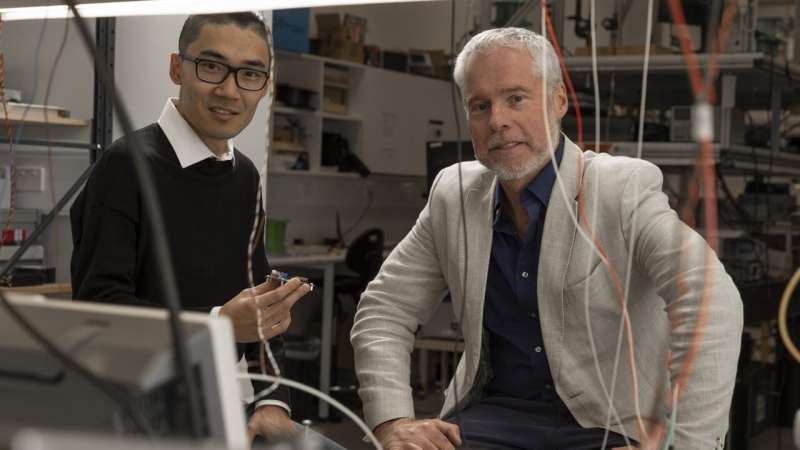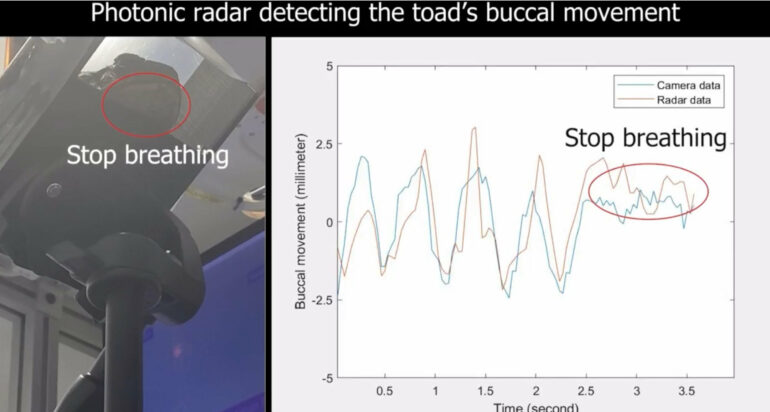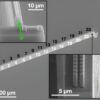Constant monitoring of vital health signs is needed in a variety of clinical environments such as intensive care units, for patients with critical health conditions, health monitoring in aged care facilities and prisons, or in safety monitoring situations where drowsiness can cause accidents.
This is now mostly achieved via wired or invasive contact systems. However, these are either inconvenient or, for patients with burns or for infants with insufficient skin area, are unsuitable.
Scientists at the University of Sydney Nano Institute and the NSW Smart Sensing Network have now developed a photonic radar system that allows for highly precise, non-invasive monitoring. The research is published in Nature Photonics.
Using their newly developed and patented radar system, the researchers monitored cane toads and were able accurately to detect pauses in breathing patterns remotely. The system was also used on devices that simulate human breathing.
The scientists say this demonstrates a proof of principle for using photonic radar that could enable the vital-sign monitoring of multiple patients from a single, centralized station.
The University of Sydney Pro-Vice-Chancellor (Research) and lead for this research Professor Ben Eggleton said, “Our guiding principle here is to overcome comfort and privacy issues, while delivering highly accurate vital sign monitoring.”
An advantage to this approach is the ability to detect vital signs from a distance, eliminating the need for physical contact with patients. This not only enhances patient comfort but reduces the risk of cross-contamination, making it valuable in settings where infection control is crucial.
“Photonic radar uses a light-based, photonics system—rather than traditional electronics—to generate, collect and process the radar signals. This approach allows for very wideband generation of radio frequency (RF) signals, offering highly precise and simultaneous, multiple tracking of subjects,” said lead author Ziqian Zhang, a Ph.D. student in the School of Physics.
“Our system combined this approach with LiDAR—light detection and ranging. This hybrid approach delivered a vital sign detection system with a resolution down to six millimeters with micrometer-level accuracy. This is suitable for clinical environments.”
Alternate approaches to non-contact monitoring have typically relied on optical sensors, using infrared and visible wavelength cameras.
“Camera-based systems have two problems. One is high sensitivity to variations in lighting conditions and skin color. The other is with patient privacy, with high-resolution images of patients being recorded and stored in cloud computing infrastructure,” said Professor Eggleton who is also the co-Director of the NSW Smart Sensing Network.
Radio frequency (RF) detection technology can remotely monitor vital signs without the need for visual recording, providing built-in privacy protection. Signal analysis, including identification of health signatures, can be performed with no requirement for cloud storage of information.

Lead author and PhD student Ziqian Zhang (left) and Professor Ben Eggleton in the photonics labs of the Sydney Nanoscience Hub. © Stefanie Zingsheim/University of Sydney
Co-author Dr. Yang Liu, a former Ph.D. student in Professor Eggleton’s team, now based at EPFL in Switzerland, said, “A real innovation in our approach is complementarity: our demonstrated system has the capability to simultaneously enable radar and LiDAR detection. This has inbuilt redundancy; if either system encounters a fault, the other continues to function.”
Conventional RF radar systems, which rely entirely on electronics, have narrow RF bandwidth and therefore have lower-range resolution. This means they cannot separate closely located targets or distinguish them in a cluttered environment.
Relying solely on LiDAR, which uses much shorter light wavelengths, provides improved range and resolution, but has limited penetration abilities through objects such as clothes.
“Our proposed system maximizes the utility of both approaches through integrating the photonic and radio frequency technologies,” Mr. Zhang said.
Working with collaborators and partners in the NSW Smart Sensing Network, the researchers hope this research provides a platform to develop a cost-effective, high-resolution and rapid-response vital sign monitoring system with application in hospitals and corrective services.
“A next step is to miniaturize the system and integrate it into photonic chips that could be used in handheld devices,” Mr. Zhang said.
More information:
Ziqian Zhang et al, Photonic radar for contactless vital sign detection, Nature Photonics (2023). DOI: 10.1038/s41566-023-01245-6
Provided by
University of Sydney
Citation:
Scientists develop photonic radar system that can remotely and accurately monitor breathing (2023, June 30)



